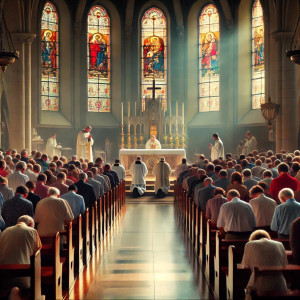On the altar, the climax of the liturgy occurs: the consecration of the bread and wine, which become the Body and Blood of Christ. This refers to Christ’s sacrifice on the Cross, celebrated in a non-bloody manner at each Mass. When Catholics have an altar in the church, they reaffirm their faith in the Eucharist as the "source and summit of all Christian life" (CIC 1324), because it is there that Christ offers Himself for us, in memory of what He did at Calvary.
Furthermore, the altar reflects the idea of communion and unity of the Church. All the faithful gather around the altar to share the one bread and the one chalice, as St. Paul teaches in 1 Corinthians 10:16-17: "The cup of blessing that we bless, is it not a participation in the blood of Christ? The bread that we break, is it not a participation in the body of Christ? Because there is one bread, we who are many are one body." Therefore, the altar is the symbol that unites Catholics around Christ and with each other.
Biblically, the altar also has its roots in the Old Testament, where it was the central place of sacrifices offered to God. However, in the New Testament, Christ's perfect sacrifice replaces the old sacrifices. In Hebrews 13:10, the author states: "We have an altar from which those who serve the tent have no right to eat." This "altar" is Christ Himself, whose unique and eternal sacrifice is made present on the church altar.
Catholics have an altar in the church because it represents Christ and His redemptive sacrifice, celebrated sacramentally. During Mass, the altar becomes the meeting point between heaven and earth, where the faithful participate in the mystery of salvation. The altar is the center of liturgical life, and through it, Catholics are more deeply united with Christ and each other in faith and the Eucharist, constantly renewing their commitment to God and the Church.

The Altar
The altar is where the consecration of the bread and wine occurs, becoming the Body and Blood of Christ. It represents the sacrifice of Jesus at Calvary and the communion of the faithful, reaffirming the Eucharist as the "source and summit of all Christian life" (CIC 1324). There, heaven and earth meet in the mystery of salvation.
-
CIC 1383
-
CIC 1324
-
CIC 1182
-
CIC 1407
-
Compendium of the Catechism of the Catholic Church 288.: https://www.vatican.va/archive/compendium_ccc/documents/archive_2005_compendium-ccc_po.html
-
Hebrews 13:10
-
1 Corinthians 10:16-17
While every effort is made to ensure accuracy and conformity with the teachings of the Catholic Church, we acknowledge that errors in interpretation or presentation may occur. If you identify any answer or content that is not in line with the official teachings of the Church, we kindly ask you to inform us. We are committed to reviewing and promptly correcting any errors that are identified.
We understand that fidelity to the Church’s doctrine is fundamental, and for this reason, we value users' collaboration in maintaining the integrity of the content presented.
We thank you for your understanding and commitment to the Catholic faith.







